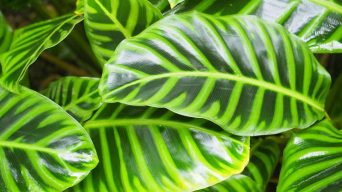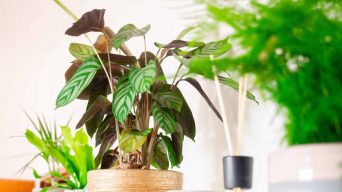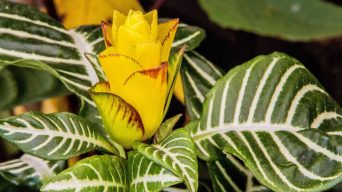The zebra plant (Aphelandra squarrosa) is a popular houseplant known for its beautiful variegated leaves. It’s a relatively easy plant to care for, but it can sometimes get leggy and lose its compact shape.
A leggy zebra plant has long, thin stems with leaves spaced far apart. This can happen for several reasons, including not enough light, too much fertilizer, or simply because the plant is getting too big for its pot.
In this article, you’ll find everything you need to know about fixing a leggy zebra plant. We’ll go over the causes of legginess, how to fix it with pruning, and other methods.
What Causes a Zebra Plant to Get Leggy?
There are a few reasons your zebra plant might be getting leggy.
The most common causes are:
1. Not Enough Light
The most common cause of a leggy zebra plant is not enough light.
Zebra plants need bright, indirect sunlight to thrive. If they don’t get enough light, they will start to stretch out in search of a light source.
Plants rely on light for photosynthesis, which is how they make food.
Without enough light, plants can’t produce the food they need to grow, so they start to stretch out in search of a light source.
This is why leggy plants are often pale and have thin, weak stems. They’re not getting the light they need to grow, so they’re growing as best they can.
2. Too Much Fertilizer
Another common cause of leggy plants is too much fertilizer.
Fertilizer is essential for plant growth, but too much can be harmful.
Overfertilizing can cause a plant to produce too much growth, resulting in long, thin stems and leaves spaced too far apart.
It can also cause the zebra plant leaves to turn yellow or brown and drop off.
High nitrogen fertilizer is particularly likely to cause legginess, so be careful not to use too much of it.
Nitrogen is the nutrient that promotes growth, so too much of it will cause your plant to grow too much.
3. Lack of Pruning
Pruning is an essential part of zebra plant care. It helps to control the shape and size of a plant, and it also encourages new growth.
It will become leggy over time if you don’t prune your zebra plant. This is because it will produce more growth than it needs, and the excess growth will be long and thin.
Pruning also helps to keep the plant healthy by removing dying or dead leaves and stems.
How To Tell if Your Zebra Plant is Leggy
There are a few signs that you can look for to tell if your zebra plant is leggy:
1. The Stems Are Long and Thin
Long, thin stems are one of the most obvious signs that a plant is leggy.
If the stems of your zebra plant are longer than usual and much thinner than they used to be, the plant is likely leggy.
This is the result of the plant stretching in search of light. The stems will be weak and will often bend or break easily.
2. The Leaves Are Spaced Far Apart
Another sign of a leggy plant is leaves that are spaced far apart.
If your zebra plant’s leaves are further apart than they used to be, it’s a sign that the plant is not getting enough light.
The plant is stretching out in search of a light source, which causes the leaves to be spaced further apart.
3. The Plant Is Pale
Leggy plants are often pale due to a lack of light.
If your zebra plant is pale or has yellow or brown leaves, it’s a sign that it’s not getting enough light.
Light is essential for plants to photosynthesize and create food.
Without enough light, the plant will become pale and leggy as it tries to reach a light source.
4. The Plant Seems Weak or Floppy
If your zebra plant seems weak or floppy, it’s a sign that it’s not getting enough light.
The stems will be thin and weak, and the leaves will often droop down.
This is because the plant doesn’t have enough energy to support its growth.
5. The Plant Leaves Are Drooping
If the leaves of your zebra plant are drooping, it’s a sign that the plant is not getting enough light.
Drooping leaves are a common symptom of a plant not getting enough light.
The plant is trying to reach for a light source, but it doesn’t have the energy to support its growth, so the leaves droop down.
6. The Plant Is Not Growing
If your zebra plant is not growing, it’s a sign that something is wrong.
Leggy plants often stop growing because they don’t have enough energy to support their growth.
This can be due to a lack of light or too much fertilizer.
If your zebra plant is not growing, try to identify the cause and take steps to correct it.
How To Fix a Leggy Zebra Plant
If your zebra plant is leggy, there are a few things you can do to fix it.
1. Move the Plant to a Bright Location
If your plant is leggy due to a lack of light, the best thing you can do is move it to a brighter location.
Zebra plants thrive in indirect light or partial shade. They need at least four hours of bright light daily to prevent legginess.
If your plant is in a dark location, it will become leggy as it tries to reach for a light source.
Move the plant to a sunny location, such as an east- or west-facing window. This will give the plant the light it needs to grow.
If you can’t move the plant to a brighter location, you can supplement its light with grow lights.
Grow lights are artificial lights that mimic sunlight. They come in various shapes and sizes and are available at most hardware stores.
Place the grow light about 12 inches from the plant and turn it on for 12 to 16 hours daily. This will give the plant the light it needs to grow.
2. Prune the Plant
Pruning is a great way to encourage a leggy plant to grow fuller and bushier.
Start by cutting off the longest stems, then trim the remaining stems to the desired length.
You can also prune off any leaves that are yellow or brown. This will help the plant focus its energy on new growth.
You must be careful when pruning, as zebra plants can easily be damaged. Use sharp, clean pruning shears, and make sure to cut at a 45-degree angle.
Pruning zebra plants is best done in the spring or summer. The plant is actively growing and can best recover from pruning.
3. Don’t Overfertilize the Plant
If your plant is leggy due to too much fertilizer, the best thing you can do is stop fertilizing it.
Zebra plants don’t need a lot of fertilizer to thrive. Too much fertilizer can cause the plant to become leggy.
Avoid using a fertilizer that is high in nitrogen. This will encourage the plant to produce more leaves, which can make the plant leggy.
If you must fertilize your plant, only do so once a month during the growing season, using a half-strength fertilizer. This will give the plant the nutrients it needs without causing legginess.
How To Prevent a Leggy Zebra Plant
You can do a few things to prevent your zebra plant from becoming leggy.
1. Place the Plant in a Bright Location
As mentioned, zebra plants need at least four hours of light daily to prevent legginess.
Place the plant in an east- or west-facing window or a bright room. This will give the plant the light it needs to grow.
Zebra plants need bright indirect light, but they should not be in direct sunlight. This can scorch the leaves and damage the plant.
You can also supplement the plant’s light with grow lights. Place the grow light about 12 inches from the plant and turn it on for 12 to 16 hours daily.
2. Turn the Plant Every Few Days
Another way to prevent your plant from becoming leggy is to turn it every few days.
Zebra plants grow toward the light. If the plant is not turned, it will start to lean toward the light source.
Turning the plant will help it grow evenly and prevent it from becoming leggy.
3. Trim the Plant Regularly
Trimming is a great way to encourage a fuller, bushier growth habit.
Start by trimming off the longest stems, then trim the remaining stems to the desired length. You can also remove any leaves that are yellow or brown.
Be careful when trimming, as zebra plants can be easily damaged. Use sharp, clean pruning shears, and make sure to cut at a 45-degree angle.
Trimming zebra plants is best done in the spring or summer. The plant is actively growing and can best recover from pruning.
You can pinch the plant’s stems to encourage a fuller growth habit. This is best done in the spring when the plant begins to grow.
4. Fertilize the Plant Properly
Zebra plants need very little fertilizer to thrive. Excessive fertilizer can harm the plant.
Fertilize zebra plants once a month in the spring and summer with a balanced, water-soluble fertilizer. Be sure to dilute the fertilizer to half-strength before applying it to the plant.
Stop fertilizing in the fall and winter when the plant is dormant.
Avoid using a fertilizer that is high in nitrogen. This can encourage the plant to grow too quickly, which can cause legginess.
5. Keep the Plant Healthy
Zebra plants are relatively low-maintenance but need proper care to stay healthy.
Make sure to water the plant regularly and fertilize it correctly. These two things will help the plant stay strong and prevent it from becoming leggy.
In addition, be sure to place the plant in a bright location. Zebra plants need bright indirect light to grow properly.
Following these simple tips, you can keep your zebra plant healthy and prevent it from becoming leggy.
Final Thoughts
Aphelandra squarrosa plants are beautiful, unique houseplants that make a great addition to any indoor plant collection. However, like all plants, they occasionally experience problems, such as leggy growth.
Thankfully, this is easy to fix with little knowledge and effort.
Following the tips in this article, you can get your zebra plant back on track and enjoy its beautiful foliage for years to come.
Thanks for reading!







